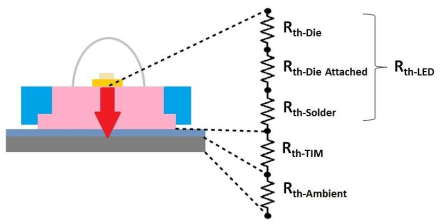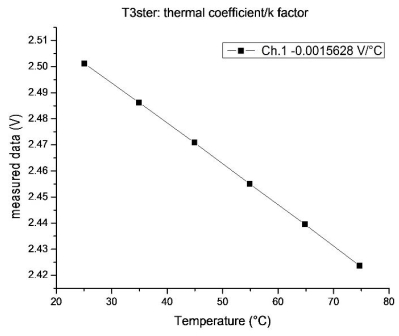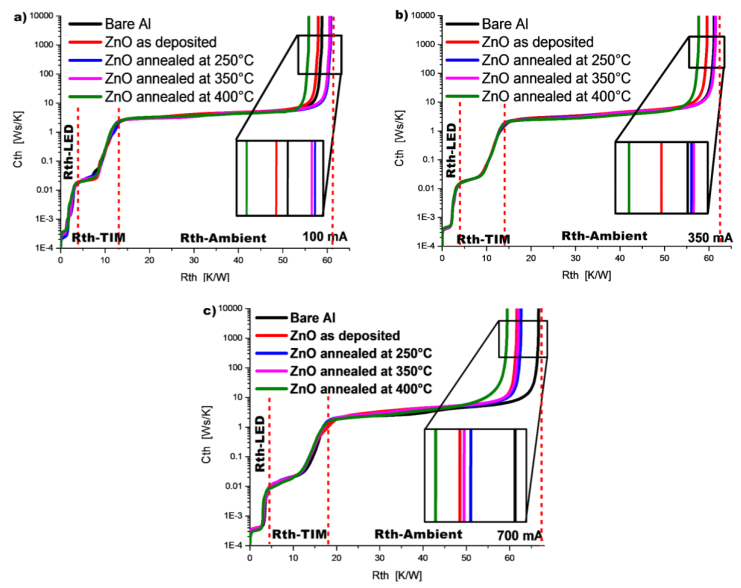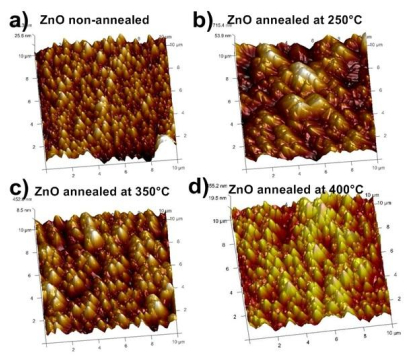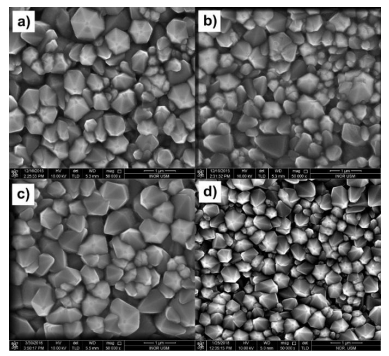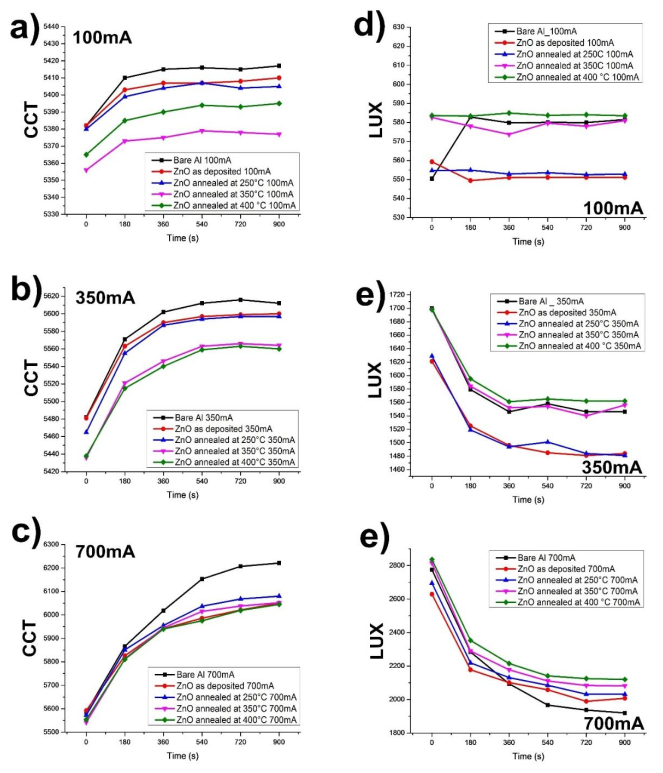1. Introduction
The advance in technology had affected the lighting industry to provide light emitting diode, and LEDs devices are not only good in the high brightness but also great in thermal performance. One of the major aspects of good lighting devices comes from the efficiency of the LED packages. Recently it was reported that the efficiency had exceeded 300 lm/W for high power LEDs [1,2]. Due to this breakthrough, LED has become the solution for next-generation lighting which can replace the traditional lighting such as standard incandescent and fluorescent lamps. The evolution and advances in power electronic technology increased the demand for miniaturized LEDs together with high performance. Miniaturization of LEDs leads to increase heat accumulation within the package. As such, effective thermal management solutions are essential to sustain the device performance [3] and the lifetime of the LEDs.
To overcome the thermal management problems, solid thin film thermal interface material can be utilized in the LEDs package as a coated heat sink or coated substrates [4]. Thermal interface material (TIM) conducts heat effectively starting from the chip to ambient in high power electronic devices. It works by connecting the discrete points of the two mating solid surfaces. The usage of thermal paste as TIM has been reported to have limitation such as dry out or pump out which leads to the degradation of the LED lifetime [5].
In recent year, Zinc Oxide (ZnO) thin film has gained much interest due to its powerful characteristics towards electronic applications. Although other metal oxides such as alumina can be used to replace ZnO due to small differences of lattice mismatch, ZnO has been proven to the fact that it is cheaper, relatively abundant, and easy to prepare compared with alumina [6]. ZnO is known to be a material that is inexpensive, nontoxic, good chemical and thermal stability. ZnO possesses high thermal conductivity (21 W/mK) giving it the ability to perform effectively in term of electrical and thermal application of a device. Moreover, ZnO thin films belong to Ⅱ–Ⅳ group and have a large exciton binding energy (60 meV), which are useful for electronic and optoelectronic application [7,8,9].
To synthesize ZnO thin film, various techniques such as CVD, spin coating, RF magnetron sputtering, spray pyrolysis, etc. have been suggested for different substrates. Among these, spin coating technique consumes a lot of time and is difficult to produce the thin film in large scale [10]. On considering, RF magnetron sputtering, it requires a vacuum environment condition, the practical use of ZnO at high-temperature causes increase in high resistivity when it is fabricated by this method [11]. Thin film deposited by spray pyrolysis technique reported a non-uniform thin film that consists of large grain size due to the uncontrollable of spraying droplet [12]. Due to these issues, CVD method has been suggested to produce a high-quality thin film with high deposition rate and precise control of film composition. Many researchers have reported high-quality ZnO thin films using CVD process. Fay et al. [13] reported that ZnO thin film showed low in resistivity with high transparency which is suitable for solar cell technology. Teresa et al. [14] reported the deposition of ZnO thin film by CVD technique under room temperature and showed high optical transparency throughout the visible and near-infrared region. This method is also suggested for low-temperature device fabrication. Consequently, it is ideal to use CVD deposition technique to produce high-quality ZnO thin film which is preferable for interface applications with suitable buffer layer thickness [15,16].
After synthesis of ZnO thin film, thermal transient measurement was used to measure the junction temperature (Tj) and the performance of the LEDs, as well as the whole package system attached on the thin film deposited Al substrates or heat sinks. Besides, transient measurement can also be used for reliability testing [1,17]. Transient measurement investigates the characteristic of power LEDs' thermal behavior at package and board level. It also performs the quality inspection on the LEDs packaging [18].
Therefore, to the best of authors' knowledge, few papers have been reported on the application of CVD processing ZnO thin film on Al substrates as a heat sink for thermal management application. This paper discusses extensively the thermal and optical performance of LED using ZnO thin film prepared by CVD as TIM on Al substrates as a heat sink and the effect of ZnO thin film layer on reducing the total as well as partial thermal resistance (Rth) of high power LED.
2. Materials and method
2.1. ZnO thin film synthesis
ZnO thin films were deposited on Al substrates (2.5 cm × 2.5 cm × 1.5 cm) using high purity zinc acetate dihydrate (Zn(CH3COO)2·2H2O, 98%, QRëCTM) without further purification as the precursor. Before the deposition, the substrates were cleaned by immersed in ethanol bath using the ultrasonic cleaner. A three-zone CVD furnace attached with quartz tube (OTP-1200X-Ⅲ) was used for the thin film deposition. The cleaned substrates were then loaded into the quartz tube and placed in the center zone (reaction zone). Approximately 4 g of Zn(CH3COO)2·2H2O powders were placed in the left zone and used as the precursor to be decomposed throughout the experiment. The schematic diagram of experimental setup for ZnO thin film deposition is shown in Figure 1. The CVD tube was evacuated using the rotary vacuum pump to maintain inert atmosphere inside the tube throughout the heating process. The tube was then filled with O2 with a flow rate of 30 sccm that acted as a gas carrier to help transfer the reactive material vapor from one zone to the other. The temperatures of the tube were set at 350,450 and 450 ℃ for the left zone, center and the right zone respectively. The deposition process was conducted for 30 minutes under atmospheric pressure. The post-annealing process was conducted in single zone furnace under an atmospheric condition at various temperatures of 250,350 and 400 ℃.
2.2. Thermal transient measurement
The thermal transient analysis was carried out using Thermal Transient Tester (T3ster). The measurement was carried out in a still air box according to JEDEC JESD-51. ZnO thin film coated Al substrate was used as a heat sink for (3 W white LED) package. The electrical test method was in accordance with JEDEC JESD-51 which was used to study the thermal transient characterization of the LED using different configuration. Three different currents (100,350, and 700 mA) was used for the thermal test at room temperature of 25 ± 1 ℃. The LED was forward biased for 900 s and the cooling transient was captured for another 900 s until steady state was attained. The measurements were repeated for all of three driving currents. The cooling profiles were then analyzed by using the T3ster Master software. The schematic diagram of the LED configuration is given in Figure 2. It can be observed that the LED package is mounted on an Al substrate employing ZnO thin film as TIM. The red arrow in Figure 2 demonstrates that the heat flow is one dimensional (1D).
Figure 2 shows the schematic diagram of testing configuration using LED and ZnO coated Al substrate with corresponding 1D resistor model for the entire package. The diagram illustrates and simplifies the thermal system of the LED package. From the figure, the resistance is created when one layer interacts with another layer. It is important to verify the individual layer in the system to identify the regions of interest in the structure functions.
Prior to the measurement, LED was calibrated before the real measurement. The dry thermostat was used as the power supply to calibrate the LED at a lower operating current of 1 mA. The temperature was set to room temperature (25 ℃) to avoid self-heating effect at the junction. Calibration was done to achieve the K factor.
The voltage drop across the junction was recorded when the temperature of the LED reached the thermal equilibrium with the temperature of the thermostat. Next, the ambient temperature was varied from 25 to 75 ℃ in 5 step sizes and the voltage drop across the junction was recorded at each defined temperature. The K factor was determined as 1.563 m V/℃ from the junction voltage against ambient temperature graph from the calibration process. Figure 3 shows the K factor determination graph for OSRAM Golden dragon LED.
2.3. Optical measurement
The optical behavior of the LED attached on CVD processed ZnO thin film was analyzed by conducting the optical measurement for 900 s at regular input current based on the electrical test method JEDEC JESD-51. The optical parameter was recorded by using an optical meter (MK350 LED meter) from UPRtek and the experiment was carried out in still air box using T3ster as the power source. Optical parameters such as correlated color temperature (CCT), color rendering index (CRI) and brightness (LUX) were measured and recorded.
3. Results and discussion
3.1. Thermal transient analysis of LED
Figure 4 shows the cumulative structure function of LED mounted on ZnO coated Al substrate. In the figure, the thermal resistance of each layer has been labeled for better understanding. Structure functions show the thermal profile recorded from the point of heat generation to the ambient. The system was divided into 3 main parts. As the current passes through the system, the heat dissipates from the LED to the ambient. In Figure 4, first part shows the Rth-LED which comprises of Rth-die, Rth-die attached and Rth-solder respectively. As noted in the datasheet, the Rth value of OSRAM white golden dragon is in the range of 5–6.4 K/W. Next, the heat flow from the TIM to the substrates contributes to Rth-TIM. As the heat moves from the Al substrates to the ambient, it creates the Rth-ambient. From the graph, it is easy to analyze the effect of heat transfer mechanism in the DUT.
To understand more on the performance of the LED, the junction to ambient thermal resistance, Rth-tot (Rth-LED to Rth-Ambient) and board to ambient thermal resistance, Rth-Ambient was evaluated from the cumulative structure function curves. The thermal transient measurement was used where LED was used as heat source. Table 1 shows the summary of Rth and rises in junction temperature, Tj of LED package fixed on Al substrates in various thin film boundary conditions. Considering all the parameters, the lowest thermal resistance was created by ZnO thin film annealed at 400 ℃ at 7.37 K/W measured at 700 mA compared with Rth-tot of bare Al. Since low Rth was achieved by ZnO annealed at 400 ℃, low junction temperature was expected where ΔTj was recorded to be 13.79 ℃. ZnO thin film annealed at 400 ℃ recorded low values of Rth-tot and Rth-b-hs for all driving currents tested. Overall observation, at 700 mA driving current, ZnO thin film as TIM is helpful to lower thermal resistance of the system. This observation shows that the heat dissipation through the TIM improves with the high driving current. The high annealing temperature improves the structure of the thin film by improving the heat dissipation. It is believed that high surface contact area and low roughness contributes to the result of lowest Rth.
Table 1. Rth and ΔTj of LED package fixed on Al substrates in various thin film boundary conditions.
| Driving current (mA) |
Bare Al |
deposited ZnO |
ZnO thin film annealed at 250 ℃ |
ZnO thin film annealed at 350 ℃ |
ZnO thin film annealed at 400 ℃ |
| Junction to ambient Thermal Resistance, Rtot-th (K/W) |
| 100 |
58.79 |
57.96 |
60.76 |
60.53 |
55.83 |
| 350 |
61.14 |
59.60 |
61.25 |
61.49 |
57.65 |
| 700 |
66.77 |
61.72 |
62.63 |
62.01 |
59.40 |
| Board to Ambient Thermal Resistance, Rth-Ambient (K/W) |
| 100 |
45.61 |
44.60 |
47.23 |
47.23 |
43.27 |
| 350 |
45.47 |
43.62 |
46.84 |
47.11 |
42.73 |
| 700 |
42.66 |
41.05 |
44.04 |
42.45 |
41.07 |
| Junction Temperature (℃) |
| 100 |
17.03 |
16.74 |
17.55 |
17.52 |
16.14 |
| 350 |
68.74 |
67.05 |
69.01 |
69.13 |
66.45 |
| 700 |
164.8 |
152.84 |
155.42 |
153.69 |
151.01 |
Table 1 also shows ΔTj of LED fixed on ZnO coated thin films and bare Al. Overall, it can be said that the ZnO thin film annealed at 400 ℃ performed well on reducing the Tj for all driving currents which agreed with the Rth result. At lower driving currents (<350 mA), no significant changes can be observed in Tj. This is because molecular agitation is expected to be slow or does not happen in the material at low temperature [20]. From the observed data, the ∆Tj value was recorded at 13.79 ℃ compared with bare Al sample at 700 mA. Moreover, at high driving currents, it can be observed that samples with ZnO thin film coating show significant changes in the Tj of LED compared with the bare Al sample. From this, it can be assumed that the ZnO thin film performed well on reducing Tj value considerably at high driving currents.
Figure 5 shows AFM images of ZnO thin films at different annealing temperatures. The root-mean-square average (RMS) roughness of the thin film was scanned and analyzed from AFM measurement. Figure 5 showed that ZnO thin film was grains-like and the roughness increased as the annealing temperature increased. Low surface roughness provided more contact area on the surface which helped in improved pathway for thermal dissipation that could result in lower thermal resistance of the thin film [21]. ZnO annealed at 250 ℃ showed larger grain which increased the surface roughness and hence produced high thermal resistance. This is due to the incomplete reaction from the zinc acetate (precursor) during the heating [22]. The small grain tends to merge into larger grain which increases the roughness of the film. The same observation was observed from ZnO annealed at 350 ℃. High surface roughness can result in high Rth which indicates poor heat transfer due to the formation of a huge gap between the thin film surface and the surface of LED. High surface roughness affects the heat path. By lowering the interface between the two surfaces, the resistance of the device can be lowered.
Surface morphologies of ZnO thin films analyzed by FESEM at different annealing temperatures are shown in Figure 6 at 50K magnification respectively. From the images, various sizes of hexagonal particle shape can be observed in all thin film boundary conditions. The particle size increases with increasing annealing temperature but eventually decreases at 400 ℃ annealing temperature. The increase in particle size is due to the thermal decomposition temperature of the precursor. It has been reported that the vaporizing temperature of zinc acetate is 240 ℃ [22]. The particle size increases due to the preferred crystal growth that is not disturbed by the post-heating at a temperature lower than the vaporizer temperature. Nonetheless, thin film annealed at 350 ℃ shows the highest particle size although the vaporize temperature is lower than the annealed temperature. This is because high thermal expansion coefficient of Al substrate helps to increase the particle size growth. When the annealing temperature was above 400 ℃, the decomposition of zinc acetate as precursor happens to decrease the particle size [23]. There is a possibility that the material annealing temperature influences the thin film performance. At higher temperature, the performance of the thin film is greatly inhibited and reduced at lower temperature [24]. Thus, it can be deduced that the particle size will decrease with increase in annealing temperature.
Table 2. Particle size and roughness of the ZnO thin films.
| Process |
Particle size (nm) |
Roughness (nm) |
| ZnO thin film as deposited |
575.62 |
76.00 |
| ZnO thin film annealed at 250 ℃ |
583.41 |
146.00 |
| ZnO thin film annealed at 350 ℃ |
772.67 |
99.20 |
| ZnO thin film annealed at 400 ℃ |
505.82 |
95.10 |
3.2. Optical performance of LED
The optical performance of LED in various boundary conditions is discussed by considering the CCT, LUX and CRI parameters. Figure 7 shows the effects of CCT and LUX on LED at different driving currents. Due to the observed changes in the CRI values were within ±5 for all boundary conditions, the CRI will not be discussed here as stated in the published result [25] which can be considered as insignificant.
The CCT values of ZnO thin film as TIM toward LED light output are shown in Figure 7a, b, c. Correlated color temperature (CCT) is the measurement of the color appearance of the light source [26]. CCT value helps to define the appearance of the color of LED (white) whether the LED falls towards the warmer, neutral or cooler site. The CCT value is observed in the range of 5355–6300 K for all boundary conditions. Hence, the LED shows that the appearance toward cool white light appearances. It can be observed that the CCT value changes as the driving current increases. Overall observation of the CCT value for LED mounted on ZnO thin film shows lower CCT value compared with the bare Al. This observation shows that ZnO thin film as TIM can increase the lifetime of the LED. From Figure 7a, at low driving current 100 mA, low CCT value for ZnO annealed at 350 ℃ was achieved rather than ZnO annealed at 400 ℃. This is because the efficiency of LED drops at low driving current. The LED performance works best at its optimum driving current > 350 mA at which it can be observed that the CCT for ZnO annealed at 400 ℃ improves as the driving current increases.
The illuminance (LUX) of the LED was measured and presented in Figure 7. LUX represents the amount of light spreading over given surface area. Overall, the result shows the LUX value on the LED mounted on ZnO thin film increases as the driving current increases. This indicates that the ZnO thin film as TIM helps to sustain high LUX value compared with the bare Al sample. ZnO thin film annealed at 400 ℃ shows high LUX value compared with the ZnO thin film in other boundary conditions. At low driving current (100 mA), the brightness of the LED shows no significant changes as the time increases while at intermediate (350 mA) and high driving current (700 mA) shows a sharp drop in LUX value and comes to steady value as the time increases.
4. Conclusions
ZnO thin films were deposited on Al substrates by CVD technique and tested as TIM (coated heat sink) for high power LED. The effect of enhanced heat transfer (post-processing) by the thin film on the thermal and optical performance of the high-power LED was discussed. ZnO annealed at 400 ℃ was found to perform effectively on reducing the thermal resistance and junction temperature of the LED. Moreover, optical properties of the LED showed improvement in CCT and LUX values. Annealed temperature below vaporization temperature of zinc acetate (240 ℃) and high thermal expansion of substrate don't help in improving the grain growth and thus increasing the roughness. To summarize, high annealing temperature is required to produce high-quality thin film that can improve the thermal and optical performance of LED. From the observed results, ZnO thin film deposited by CVD can be an alternative interface material for thermal management in LED packaging.
Acknowledgment
This work was financially supported by Collaborative Research in Engineering Science and Technology (CREST) under grant (304/PFIZIK/650788/C121).
Conflict of interest
The authors declare that there is no conflict of interest regarding the publication of this manuscript.










 DownLoad:
DownLoad: 